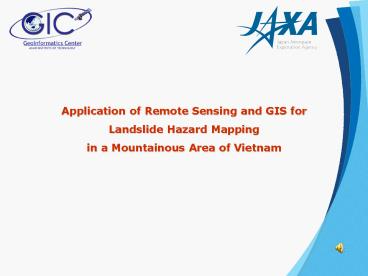Application of Remote Sensing and GIS for Landslide Hazard Mapping in a Mountainous Area of Vietnam - PowerPoint PPT Presentation
1 / 25
Title:
Application of Remote Sensing and GIS for Landslide Hazard Mapping in a Mountainous Area of Vietnam
Description:
Land Hazard Zonation using SINMAP Model ... Land initiation points that fall in the region where the stability index ... – PowerPoint PPT presentation
Number of Views:2211
Avg rating:3.0/5.0
Title: Application of Remote Sensing and GIS for Landslide Hazard Mapping in a Mountainous Area of Vietnam
1
Application of Remote Sensing and GIS for
Landslide Hazard Mapping in a Mountainous Area
of Vietnam
2
Introduction
- Two-third of the land of Vietnam is occupied by
steep mountainous terrains and they are prone to
landslides. - According to the Committee for flood and storm
control of Vietnam, rain-triggered landslides
have become increasingly complex in the northern
mountainous area with an average of 2-3 times per
year. - As a result, most of the residential areas,
transportation systems, irrigation and economic
infrastructure located in the mountainous areas
vulnerable to landslides.
3
Study Area Son La Province
Yen Chau Bac Yen Districts Area 650 sq. km.
1040 15' E to 1040 30' E 210 15' N to 210
30' N
4
Objectives
- To produce landslide hazard maps using a
stability index based and probabilistic
approaches. - To study the applicability of these models under
local conditions.
5
Main Steps
Data Collection and Data Processing Landslid
e Hazard Zonation using SINMAP Model Landslid
e Hazard Zonation using Weighted Overlay Analysis
(WOA)Comparison of Results
Step 1 Step 2 Step 3 Step 4
6
Data Collected
- GIS LAYERS
- Contours map (scale 150.000 Source MONRE), as
of yr 2002. - River network (scale 150.000 Source MONRE), as
of yr 2002. - Road network (scale 150.000 Source MONRE), as
of yr 2002. - Soil map (scale 1200.000 Source MONRE), as of
1996. - Geology map (scale 1200.000 Source Geology and
Mining Bureau). - Land cover map (Source Extract from Satellite
image). - REMOTELY SENSED DATA
- ASTER, Mar 2003 ALOS-AVNIR 2, Dec 2006
(GIC-JAXA). - OTHER
- Rainfall data (Monthly Source Hydrometeorology
Department), as of yr 2005. - Partly complete inventory of landslide points
(Source Geology and Mining Bureau), as of 2000.
7
Data Collected through Field Visit
A wide open crack in the road produced by an
active landslide in Hong Ngai
Scar of Huoi Thon major landslide
Soil sampling at a shallow landslide location in
Huoi Thon
Typical land cover
A shallow slide in Bac Yen
Point positioning using GPS
8
Methodology SINMAP
Satellite image
DEM
Process
Contour Map
Landslide inventory
Local Authority/Field Visit
SINMAP
Geotechnical data
Landslide points Calibration
Hydrology data
Stability Index Map SINMAP Based Landslide
Susceptibility Map
9
SINMAP Inputs
Digital Elevation Model Map of the study area
10
SINMAP Inputs
Calibration Region Theme A polygon coverage of
soil types distributed over the study area was
used as calibration region
11
SINMAP Inputs
Model parameters used for the initial run
12
SINMAP Results
13
Summary of SINMAP Results
14
Methodology WOA
Parameter weight using AHP
SLOPE
DEM
Satellite image
Land cover
Weight overlay analysis
Geology
Susceptibility Index Map
Soil
Reclassify
Road
River
Landslide Hazard Map
15
Weighted Overlay Analysis
1. Pairwise Comparisons
- Assessing Consistency of Pairwise Judgments
- Criterion Inconsistency index (II) 0.1
- Computing the Relative Weights the study employs
the Eigenvalue technique
16
Weighted Overlay Analysis
- Produce a reclassified grid theme (RGT), the
cells of which should be attributed with
corresponding values of earned weights. - Carry out a weighted overlay analysis
- Susceptibility Index Map (w1 x RGT1) (w2 x
RGT2) (w3xRGT3) - Where wi is the weight of the
corresponding parent factor - Reclassify the Map calculation output to produce
the Landslide Hazard Zonation Map.
17
Processed and Collected Factor Maps
18
Weights of Parent Factors through AHP
Max Eigen Value
Eigen Vector
19
Weights of Parent and Child Factors
20
Results WOA
21
Landslide Susceptibility Map from WOA
Landslide Susceptibility Index Map
22
Summary from WOA
23
Comparison of Results
24
Conclusions
- Remotely sensed data, i.e. ASTER and
ALOS/AVNIR-2 satellite images have successfully
been used to prepare the DEM and land cover map
as inputs for the study. However, use of
high-resolution satellite images such as
ALOS/PRISM will provide accurate DEM for better
results. - The stability index map output from the SINMAP
model indicate that 40 of this mountainous
terrain fall under the defended slope category.
However, only 25 of the recorded landslides were
found to fall in this region. Landslide
initiation points that fall in the region where
the stability index lt 1 is found to be only 50.
Further calibration due to limited landslide
inventory points failed to improve the results. - Under the circumstances, the stability index map
output from the SINMAP could not conveniently be
adopted as a Landslide Hazard Map.
25
Conclusions (Continued)
- The same limitation of limited landslide
inventory applies to the Weighted Overlay
Analysis method as well. The method also falls
short of all factor maps to be taken into account
in the analysis. However, in identifying the very
high hazard zone the Weighted Overlay Analysis
method did a better job than SINMAP. It is,
therefore, expected that for the selected study
area, Weighted Overlay Analysis method with an
exhaustive landslide inventory and a complete set
of factor maps might have a better potential in
predicting the landslide occurrences. - A complete landslide inventory is crucial in
validating and predicting landslide occurrences.
In a very difficult terrain such as the area
selected for this study, remotely sensed data
will be very useful for preparing an inventory
the landslide occurrences. In this connection,
fusion of ALOS-PRISM and ALOS-AVNIR-2 to produce
very high-resolution images of natural color
composite will be not only useful, but also cost
effective.































